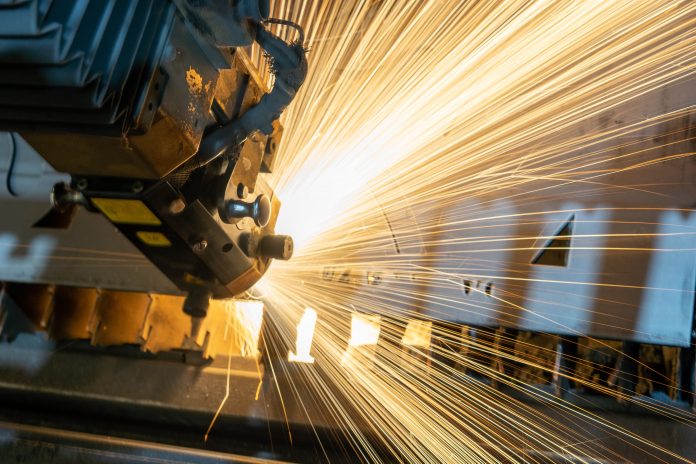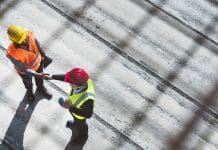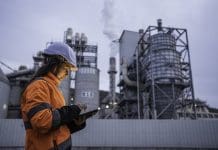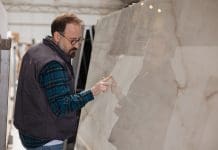Unfortunately, construction workers face disproportionate mental and physical risks to their health whilst working. This guide offers advice to those in the industry to prevent accidents and make the construction sector a safer, happier place to work
“Innovations in safety technology can save lives and provide peace of mind for workers in construction” says Naz Dossa, CEO, Peoplesafe.
Last year, Health & Safety Executive (HSE) statistics found that the construction industry had the most fatalities of all industries in the UK – they face disproportionate mental and physical risks. Working in construction is undoubtedly a career path that carries significant risk but, rather than accept this and carry on as usual, perhaps it is time to take a fresh look at on-site health and safety protocols to see if there is room for improvement.
An employer’s responsibilities are laid out by the Health and Safety at Work Act (1974), with requirements for risk assessments made more explicit through the Management of Health and Safety at Work Regulations 1999. It is here that employers can find detailed guidance on what a risk assessment should entail – and this is broken down into practical steps on the HSE’s own website.
Understanding duty of care – some questions to ask
In the current climate, duty of care means putting the right measures in place to allow employees to carry out their work safely and without any undue stress or concern. In order to guarantee that this is happening, there are some basic questions that it is worth asking:
- Is everyone clear in their understanding of what their roles and responsibilities are?
- Do workers have adequate PPE which they know how to use or wear?
- Do they understand why it is necessary?
- Do workers know how to use the equipment properly?
- Have they had refresher training if they’ve been using it for a long time?
- Would staff know what to do in a critical situation?
- Are there mental wellbeing checks in place?
- Does everyone know what signs to look out for in a colleague or themselves?
Asking these questions on a regular basis will help an organisation to focus on the measures that are in place and whether there is anything further that could – or should, be done.
Identifying and reducing physical risks in construction
The HSE report into fatalities in the construction industry also found that the number one cause of death was by falling from height, followed by being struck by a moving vehicle or object. Construction workers are regularly required to use large tools and operate a variety of machinery, often at height and sometimes in environments where hazardous materials are present. The physical risks are very real – but the majority can be avoided.
Accidents can – and do – happen and those who find themselves working alone or out of the earshot of colleagues are particularly vulnerable. Should someone be incapacitated by tripping and falling for instance, they could be reliant on someone else arriving at the scene in order to get help. Even the smallest accidents can turn into something more serious, even potentially fatal, if help is not easy to come by.
Complacency is another risk factor that can be overlooked and may not be as obvious to an employer. When someone is comfortable in their role and used to carrying out the same tasks, mistakes can still be made. It’s easy to let your mind wander whilst completing a routine job, which can result in an incident.
Including workers in the risk assessment process can heighten their safety consciousness and highlight any unknown or unforeseen hazards. Getting their input can help to put robust safety measures and processes in place that are more likely to be followed.
How technology can help with physical risks
Last year, Peoplesafe surveyed over 120 health and safety specialists and found that 71% of firms planned to invest in lone worker technology and smart PPE within the next three years. We have seen a significant shift towards the reliance on technology and smarter solutions to help protect employees and that is only likely to increase as technological advances continue to be made.
When it comes to personal safety, there are a number of solutions beyond traditional forms of PPE (e.g. hard hats and steel toe-capped boots) to keep workers safe. Dedicated SOS devices and apps can proactively ensure staff safety whether they are surrounded by colleagues or find themselves working alone.
By pressing the SOS button, a two way communication channel is opened with a trained incident manager who will also receive the user’s GPS location to within 3m² and their personal profile created during setup. Additional features including fall detection are available to assist when a user slips, trips or falls by sensing a sudden impact on the device and a change in orientation to automatically trigger an SOS alert.
Devices with geofencing capabilities work well on site by sending an automatic message when someone enters a fenced area to remind them about the safety protocols in that space. For instance, a reminder that hard hats and appropriate footwear are mandatory.
Peoplesafe has an in-house Alarm Receiving Centre (ARC) where expert Controllers are available 24 hours a day, seven days a week, 365 days a year to assess any given situation and contact the appropriate emergency service, bypassing 999 and guaranteeing that someone will be at the scene in the quickest time possible.
Carrying a simple-to-use safety device which can be used at any time not only provides reassurance and assistance during the working day, but can also be utilised outside of working hours – a perk of the job at no extra cost to the employer.
An example of physical risk
The team at Peoplesafe have seen first hand how technology can help on a construction site when someone was suffering shortness of breath whilst operating heavy lifting equipment. They weren’t able to get the attention of the crew on the ground but activated their SOS alert where they were connected to a call handler in the ARC who was able to get an ambulance sent to the scene just four minutes later as the Peoplesafe Controller used the Unique Reference Number (URN) to bypass the 999 system.
Mental health risks faced by workers in construction
Mental health risks are just as significant as physical risks in the industry. Mental Health First Aid reports that two people in the construction industry die by suicide every day in the UK. This is a shocking statistic and something that the construction industry is already working hard to improve.
It is vital to recognise that the signs exhibited by each person will be different – and that some people will not exhibit any signs at all. Some key indicators that employers should look out for include:
- Suddenly reduced or unpredictable performance
- Neglect of safety advice or more accidents
- Withdrawal; being difficult to reach by phone or electronic means
- High rates of sickness absence
- Being short tempered or having outbursts of anger
Technology has a role to play in helping to raise awareness of a worker who is suffering with poor mental health before it becomes a crisis situation. There are apps, for instance, that have wellbeing checks, asking users a short series of questions on a regular basis. The answers given will then enable the app to assess the user’s state of mind and raise the necessary alert should it be required.
There are also apps that help specifically with mental health, providing actionable tools and insights that help individuals to manage their condition and form good habits that will safeguard their mental health in the future.
Call handlers at Peoplesafe’s ARC are trained to handle suicide calls and have, in fact, handled a steadily increasing number of calls – usually from people in the presence of someone who is suicidal.
Workers who are on their own or out of earshot
The first step in protecting lone workers is ensuring that both employers and employees alike understand why lone working is riskier than working as part of a team. The problem isn’t necessarily that the job they are doing is a more dangerous one; it’s that there is usually nobody to call on if things go wrong. In the construction industry this is a particular concern due to the nature of the tasks being completed and the equipment used on a daily basis.
When it comes to making on-the-spot safety decisions, lone workers are once again faced with an increased risk. No opportunity for a second opinion means a raised possibility of poor decision making – in some cases leading to workers placing themselves in unnecessary danger or in situations that can quickly escalate and become unmanageable for one person alone.
And while some lone workers will value the autonomy of their role, they are far more likely to suffer from psychological distress, anxiety and loneliness than their team-working counterparts.
Next steps for a safer construction industry
We have all become aware in recent years of the higher than average threat to mental and physical wellbeing in the construction industry. Our next steps for reducing these statistics lie in taking a forward thinking approach, keeping up to speed with innovations in the health and safety arena and putting systems and processes in place to combat the risks.
Complacency is the enemy, so keeping yourself and your workforce fully trained with regular reviews of systems and practises enables everyone to do their jobs, secure in the knowledge that every opportunity for safety has been considered. A secure workforce leads to a secure and productive business.

















